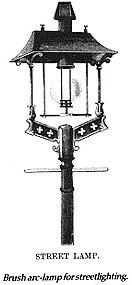
| |
 |
![]()
 These lamps work best in the direct current that alternative energies such as wind or water mills will furnish, and carbon is a readily available
natural substance. Encyclopedia Britannica gives the historical background on carbon arc lamps as street lights:
These lamps work best in the direct current that alternative energies such as wind or water mills will furnish, and carbon is a readily available
natural substance. Encyclopedia Britannica gives the historical background on carbon arc lamps as street lights:
The incandescent lamp was not the first electric lamp; lighting devices employing an electric arc struck between electrodes of carbon had been developed and were in use earlier. Arc lamps were massive and complicated pieces of equipment that could be installed and maintained only by a skilled engineer. Used for street lighting, arc lamps had advantages, including reasonable reliability, high efficiency, and above all, a pleasant color, closely approximating natural sunlight. The light of the arc lamp was particularly kind to the color of the human complexion and the stone of historic buildings. Partly for this reason, these devices were retained in dignified city settings - for example, in the City of London - long after more modern light sources had come into wide use. A device for producing light by maintaining an electric arc across a gap between two conductors; light comes from the heated ends of the conductors (usually carbon rods) as well as from the arc itself. The Yablockhkov candle, an arc lamp invented by the Russian engineer Paul Yablochkov, was used for street lighting in Paris and other European cities from 1878.
Carbon Arc lamps were used to light the streets of London and Paris, with a light that approached the light of day.
Yes, there were electric lights powered by central stations before Edison's! Carbon arc lamps saw extensive use throughout the USA and the world from the late 1870s on. Due to their intense light they were not that practical for lighting small interior spaces. However even after the advent of the incandescent bulb, arc lamps survived for decades being used as streetlights and for lighting large interior spaces like factories, mills, and department stores. Early incandescent lamps produced about 16 candle power, while arc lamps produced 2,000-4,000 candle power. Incandescents just didn't have the output or efficiency of arcs. Today carbon arcs are still used in some large spotlights and projectors.
How do arc lamps work? Well two carbon rods connected to a current limited source are brought together and then drawn apart. As the carbons separate, a hot ionized path is created between them (the arc) that continues to conduct after the carbons have been separated. This arc burns at thousands of degrees and heats the ends of the carbons to incandescence. Most of the light comes from the tips of the carbons, not the arc itself. As the carbons burn down they need to be constantly adjusted to maintain the proper spacing so that the arc does not go out. Part of what is fascinating about early lamps is the range of ingenious mechanisms that were used to do this. Everything from manually adjusted designs to complex clockwork mechanisms were tried, and as you might guess reliability became a major issue. One design overcame this hurdle and became commercially successful by the late 1870s ushering in the era of electric light.